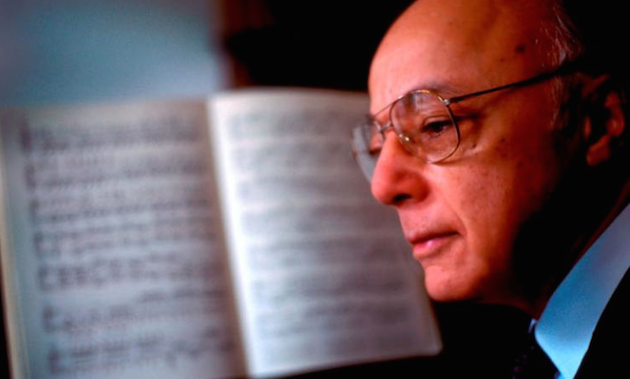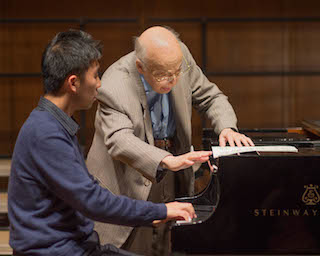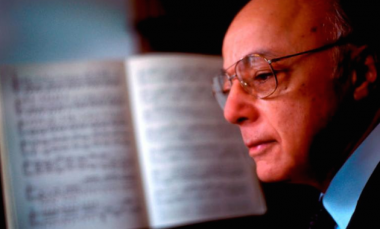
Seymour Lipkin is unquestionably the doyen of piano pedagogy today. A pedagogue of pedagogues, he has held teaching positions for decades at Juilliard and Curtis, in addition to an extensive career as a pianist and a conductor spanning nearly 70 years. Yet, Lipkin continues to perform and record, leaving a legacy unequalled today.
Lipkin’s solo recital Friday was a part of the second annual Piano Institute program, at UC Berkeley, presenting a series of performances, lectures, and master classes. Lipkin was joined by Kenneth Hamilton, Suzanne Macahilig, Chuck Fuery, and Malcolm Bilson, on topics surrounding piano repertoire and pianism itself.
The recital program centered around Beethoven’s last two sonatas: Op.110 in A-flat Major, and Op.111 in C Minor, accompanied by a Mozart Sonata in F-Major, K.332, and George Walker Sonata No.5.
In both of the Beethoven sonatas, Lipkin presented an unblemished narrative, devoid of unnecessary embellishments and extraneous accoutrements. The purity of lines, with long lyrical lines helped define a clear outline of the motifs and counterpoints. Free of gimmicks that often contaminate these oft-heard pieces, Lipkin maintained the level of sincerity and timelessness from another era.
In particular, the fugal sections of the last movement of the Sonata, Op.110 possessed a quality of the embracing, divine warmth of the heavenly light. But all the serenity did not at all rob the music of the drama and anguish. Indeed, the calm was the backdrop against which more earthly struggles in the earlier movements were depicted.
One distinguishing characteristics of Lipkin’s performance was the sensitive use of the sustain pedal. Pianists often neglect the importance of the pedal as a mean to control the harmonics of the instrument, rather than merely to hold the notes after being played. Lipkin often held the pedal across phrases, yet without sacrificing the phrases themselves. This helped thread phrases together, constructing a large structure.
From Lipkin’s timeless recital, through Fuery’s case for improvisations, and Bison’s performance on a period instrument, the program was a powerful reminder to today’s pianists to strive to understand the original intent of the composers.
The program opened with a vibrantly poignant interpretation of the Mozart Sonata in F-Major, K.332 with stately elegance. Music rolled out into the air, as if it were a thread of the finest silk. Yet, there were lively jabs of dissonant notes, The suspended B-flat notes in the last movement created a delightful tension, while parallel thirds in the second movement were strung together like an extravagant double pearl strand.
Lipkin also presented the fiery Sonata No.5 by American composer, George Walker. Though brief, the bold character rich in octave unisons came out as devastating punches. The anguish depicted in diminished chords full of tritone intervals were dark, yet sparks of ecstatic lines gave vibrantly colorful contrasts.

The Piano Institute also presented masterclasses and lecture. Of particular fascination was Chuck Fuery’s lectures and masterclasses on 19th century improvisations, particularly on Chopin. Fuery provided a convincing case for improvisation, as Chopin often wrote brief introductions in many of his compositions. Fuery stated that such introductions were often improvised on the spot, a practice that was lost in the 20th century, perhaps with the advent of the recording technology. Fuery emphasized the importance of understanding the mindset of the composers, and the historical context.
Speaking of historical context, Malcolm Bilson gave a recital of the classical repertoire, on a modern replica of an instrument Mozart favored. While the power and the dynamic range of modern pianos are seductive, Bison brought the audience back to the core of the music, presenting a convincing case for not indulging in the ample opiates from modern instruments. Stripped of rich harmonics and long sustain, the music was stripped to its notes, reminding us to better explore and understand the composers’ context and intentions.
In the end, appreciation of the composer’s intentions was the overarching theme of the program. From Lipkin’s timeless recital, through Fuery’s case for improvisations, and Bilson’s performance on a period instrument, the program was a powerful reminder to today’s pianists to strive to understand the original intent of the composers. For that I came away inspired to explore further into the mind of the composers.

